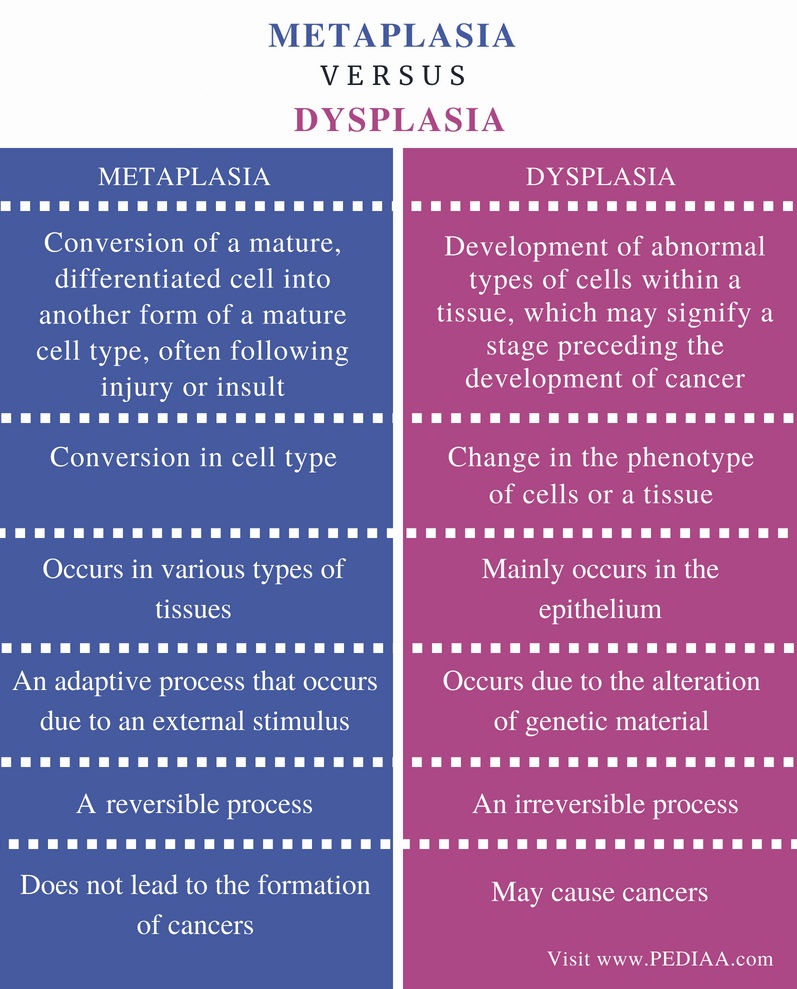Metaplasia: Definition, Types of Metaplasia, Epithelial Metaplasia, Mesenchymal Metaplasia, Examples of Metaplasia, Symptoms, Difference Between Metaplasia and Dysplasia and MCQs for NEET, GPAT, CSIR NET JRF
“Metaplasia is a condition in which one adult cell type (epithelial or mesenchymal) is replaced by another adult cell type.”
1.] Metaplasia is a type of reversible change.
2.] Metaplasia is an adaptive response.
3.] The most common adaptive metaplasia is columnar to squamous, as occur in the respiratory tract in response to chronic irritation.
The above image is taken for education purpose only from mypathologyreport.ca
EPITHELIAL METAPLASIA: –
This is the most common type of metaplasia. The metaplastic change may be patchy or diffuse and usually result in replacement by stronger but lesser well specialised cells.
Due, to less specialised cell there will be deprivation of mucus which make it more prone to infection.
There are two types of Epithelial Metaplasia:

The above image is taken for education purpose only from researchgate.net
A.] SQUAMOUS METAPLASIA: Due to chronic irritation that may be chemical, mechanical or infective in origin may lead to many specialized cells into Squamous metaplasia.
Some of the common examples of Squamous Metaplasia are:
- In bronchus normally lined by pseudostratified columnar ciliated epithelium in chronic smokers.
- In uterine endocervix normally lined by simple columnar epithelium in prolapse of the uterus and in old age.
- In prostate normally lined by simple columnar epithelium in chronic prostatitis and oestrogen therapy.
- In renal pelvis and urinary bladder normally lined by transitional epithelium in chronic infections and stones.
- Gallbladder lined by simple columnar epithelium in chronic cholecystitis with cholelithiasis.
B.] COLUMNAR EPITHELIUM: There are some conditions in which there is transformation to columnar epithelium. For example:
- Intestinal metaplasia in healed chronic gastric ulcer.
- Conversion of pseudostratified ciliated columnar epithelium in chronic bronchitis and bronchiectasis to columnar type.
- In cervical erosion (congenital and adult type), there is variable area of endocervical glandular mucosa everted into the vagina.
- Columnar metaplasia in Barrett’s oesophagus, in which there is a change of normal squamous epithelium to columnar epithelium.
MESENCHYMAL METAPLASIA: –
There is a transformation of one adult type of mesenchymal tissue to another.
Some of the examples of Mesenchymal metaplasia are as follows:
- Osseous metaplasia is the formation of bone in fibrous tissue, cartilage and myxoid tissues.
- In arterial walls in old age.
- In soft tissues in myositis ossificans.
- In cartilage of larynx and bronchi in elderly people.
- In scar of chronic inflammation of prolonged duration.
- In the fibrous stroma of tumour.
SYMPTOMS OF METAPLASIA: –
Following are some of the common symptoms of metaplasia:
- Indigestion
- Bloating (a swollen state caused by retention of fluid or gas)
- Loss of appetite
- Nausea
- Vomiting
- Under abdominal pain
- Belching (burping)
- Weight loss due to loss of appetite
DIFFERENCE BETWEEN METAPLASIA AND DYSPLASIA: –

The above image is taken for education purpose only from pediaa.com
MULTIPLE CHOICE QUESTIONS: –
1.] The condition in which one adult cell type in converted into another adult cell type is called?
a. Metaplasia
b. Apoptosis
c. Hyperplasia
d. Hypertrophy
2.] Metaplasia is?
a. Non-reversible change
b. Reversible change
c. Both (a) and (b)
d. None of the above
3.] What kind of response does metaplasia give?
a. Adaptive response
b. Non-adaptive response
c. Both (a) and (b)
d. None of the above
4.] Which of the following are the types of metaplasia?
a. Epithelial Metaplasia
b. Mesenchymal Metaplasia
c. Both (a) and (b)
d. None of the above
5.] Which of the following is the most common adaptive metaplasia?
a. Columnar to epithelial
b. Columnar to transitional
c. Squamous to columnar
d. Columnar to squamous
6.] Which is the most common type of metaplasia?
a. Epithelial metaplasia
b. Mesenchymal metaplasia
c. Both are equally common
d. None of the above
7.] Which of the following are the types of Epithelial metaplasia?
a. Squamous metaplasia
b. Columnar metaplasia
c. Both (a) and (b)
d. None of the above
8.] Intestinal metaplasia in healed chronic gastric ulcer. It is an example of Columnar metaplasia, True or False.
a. True
b. False
9.] What are the common symptoms of Metaplasia?
a. Loss of appetite
b. Weight loss
c. Belching
d. All of the above
10.] Which of the following are the examples of Mesenchymal metaplasia?
a. In arterial walls in old age
b. In scar of chronic inflammation of prolonged duration
c. In cartilage of larynx and bronchi in elderly people
d. All of the above
SOLUTIONS: –
1.] (a) Metaplasia
2.] (b) Reversible change
3.] (a) Adaptive response
4.] (c)
5.] (d) Columnar to squamous
6.] (a) Epithelial metaplasia
7.] (c)
8.] (a)
9.] (d)
10.] (d)
List of Successful GPATINDIAN CANDIDATES
Participate in Online FREE GPAT TEST: CLICK HERE
Participate in Online FREE Pharmacist TEST: CLICK HERE
Participate in Online FREE Drug Inspector TEST: CLICK HERE
Participate in CSIR NET JRF Mock Test
REFERENCES: –
1.] Textbook of Pathology by Harsh Mohan; 7th edition; Page no.39 – 41.
2.] Robbin’s Basic Pathology; 5th edition; Page no.48 – 49.